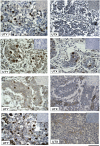AZFa candidate gene UTY and its X homologue UTX are expressed in human germ cells
- PMID: 35128450
- PMCID: PMC8812439
- DOI: 10.1530/RAF-20-0049
AZFa candidate gene UTY and its X homologue UTX are expressed in human germ cells
Abstract
The Ubiquitous Transcribed Y (UTY a.k.a. KDM6C) AZFa candidate gene on the human Y chromosome and its paralog on the X chromosome, UTX (a.k.a. KDM6A), encode a histone lysine demethylase removing chromatin H3K27 methylation marks at genes transcriptional start sites for activation. Both proteins harbour the conserved Jumonji C (JmjC) domain, functional in chromatin metabolism, and an extended N-terminal tetratricopeptide repeat (TPR) block involved in specific protein interactions. Specific antisera for human UTY and UTX proteins were developed to distinguish the expression of both proteins in human germ cells by immunohistochemical experiments on appropriate tissue sections. In the male germ line, UTY was expressed in the fraction of A spermatogonia located at the basal membrane, probably including spermatogonia stem cells. UTX expression was more spread in all spermatogonia and in early spermatids. In female germ line, UTX expression was found in the primordial germ cells of the ovary. UTY was also expressed during fetal male germ cell development, whereas UTX expression was visible only at distinct gestation weeks. Based on these results and the conserved neighboured location of UTY and DDX3Y in Yq11 found in mammals of distinct lineages, we conclude that UTY, such as DDX3Y, is part of the Azoospermia factor a (AZFa) locus functioning in human spermatogonia to support the balance of their proliferation-differentiation rate before meiosis. Comparable UTY and DDX3Y expression was also found in gonadoblastoma and dysgerminoma cells found in germ cell nests of the dysgenetic gonads of individuals with disorders of sexual development and a Y chromosome in karyotype (DSD-XY). This confirms that AZFa overlaps with GBY, the Gonadoblastoma susceptibility Y locus, and includes the UTY gene.
Lay summary: AZFa Y genes are involved in human male germ cells development and support gonadoblastoma (germ cell tumour precursor cells) in the aberrant germ cells of the gonads of females with genetic disorders of sexual development. The AZFa UTY gene on the male Y chromosome is equivalent to UTX on the female X chromosome. These genes are involved in removing gene regulators to enable activation of other genes (i.e. removal of histone methylation known as epigenetic modifications). We wanted to learn the function of UTY and UTX in developing sperm and eggs in human tissues and developed specific antibodies to detect both proteins made by these genes. Both UTY and UTX proteins were detected in adult and fetal sperm precursor cells (spermatogonia). UTX was detected in egg precursor cells (primordial germ cells). UTY was detected in gonadoblastoma and dysgerminoma tumour cells (germ cell tumours originating from genetic disorders of sexual development due to having a Y chromosome). Based on our study, we conclude that UTY is not only part of AZFa, but also of GBY the overlapping gonadoblastoma susceptibility Y region.
Keywords: AZFa locus; GBY tumour susceptibility locus; UTX (KDM6A); UTY (KDM6C); human spermatogonia function.
© The authors.
Conflict of interest statement
There is no conflict of interest that could be perceived as prejudicing the impartiality of the research reported.
Figures




References
-
- Bloomer LDS, Nelson CP, Eales J, Denniff M, Christofidou P, Debiec R, Moore J, Cardiogenics Consortium, Zukowska-Szczechowska E,, Goodall AH. et al. 2013. Male-Specific Region of the Y Chromosome and Cardiovascular Risk. Phylogenetic Analysis and Gene Expression Studies. Arteriosclerosis, Thrombosis, and Vascular Biology 33 1722-1727. (10.1161/ATVBAHA.113.301608) - DOI - PubMed
Publication types
MeSH terms
Substances
LinkOut - more resources
Full Text Sources
Medical

